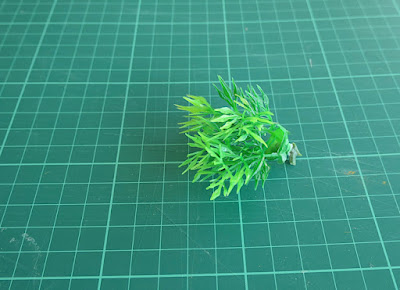 |
For some time now, I have wanted to get a more textured, 3D look for crop fields, but have never really found the right materials. Either the leaves are too big or the wrong shape etc.
I did see an overseas seller doing corn plants, but by the time they are bought in the needed numbers, the cost is quite off-putting to this gamer.
Anyway, over the past few months, I have been making regular visits to an aquatic store, checking out their plastic plants. Last week, I was pretty sure that I had found something that might do the job.
Above - these balls are formed from lots of smaller plant like florets (is that the right word?). The label describes these as Classic Aquatics - Code 4713.
They were sitting next to another tray that had slightly smaller and tighter balls, which had a different code and might just be useful for smaller scales. There is a web address on the label, this being www.classicpetproducts.co.uk
Above - taking these apart with scissors or snippers gives us a ring of the florets. The individual plants can be cut off these bunches. You end up with stems that can pass for individual plants averaging 3 - 4cm in height.
 |
| Click for detail |
Above - For construction, I went with an 80mm x 80mm MDF base (2mm thick) and gridded it off into 20mm squares. Then on the intersections drilled small holes with a Dremel.
This seems to give a good comprise between foliage density, but giving enough room (just) to get the basing paste into the centre of the piece. I used one of those fancy pants strong general adhesives.
Above - once done, a basing paste was made up with a significant proportion being from the Vallejo Textured Mud pot, which has a blackish brown hue, to hopefully resemble soil.
This was pushed towards the centre of the base using a very thin and long artists palette knife. Once fully covered and dry, dabs of PVA glue were applied to exposed spots and my flock mix sprinkled over it. I have little idea what is in the flock tub, it has grown into an anonymous mass over a number of years as various bags of flock just get added.
Finally, I did a quick pass with an airbrush with German Yellow Vallejo paint, just to take the edge off the vibrancy of the lush green. I used the yellow from their primer series in the hope that this might better adhere to the plastic leaves. The base edge was painted green.
So, there we are - done. You may think it either does or doesn't look crop like. At first, I wasn't too sure, but then I thought about the sort of terrain that I was making as a youth with no money and limited materials, yet I hugely enjoyed whatever was on the table.
The point is, sometimes I think we have made ourselves a picture perfect world and lost something along the way. For me, these will do the job as a representational corn field for ACW or a Rye field for Napoleonics. I don't even know what rye looks like ... so I suppose that may be an advantage :-).
There were rye fields at Quatre Bras 1815, described as being 6 - 7 feet tall.
Above - To start with, I just built four test bases, which gives a 2x2 field grid, with a small enough footprint that it is a good compromise for my small table and the 28mm troops.
I will build another five bases, so that my field can grow to 3x3 if needed.
Above - the idea was always that the troops should fit IN (not ON) the field and with the minimum of fuss. To that end, I am going to treat a field just like a Built Up Area (BUA), that is, it can only be occupied by one unit at a time, facing an enemy that wants to eject it.
You just pay half your movement allowance and you are in ... likewise to leave.
Above - finally and well off topic, with some progress done, I will soon be ready to do an update (number two) to the Napoleonic 1809 Project. Here we have the French command stand, with Napoleon (of course) and Mameluke Ali.
These castings are Perry metals and I got the pairing inspiration from a similar base that Iain (Caveadsun 1471 Blog) recently showed on his blog. Thank You.






